A Conversation with Andrew Moore
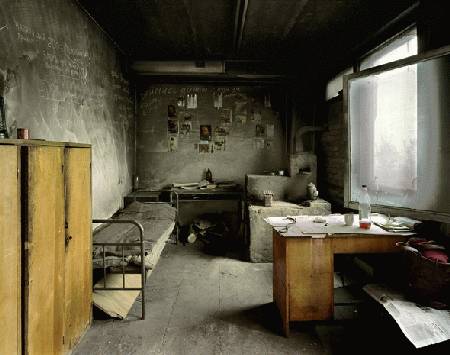
Andrew Moore’s Russia is quite an impressive book (see my review). When I asked Andrew whether he would be willing to talk about it, much to my delight he agreed immediately.
Jörg Colberg: I was very impressed by your photography in Russia, especially given the wide range of locations you were able to use. Given Russia’s History, this must have been quite the endeavor. How did you manage to get access to so many different sites, some of which I would have thought to be completely inaccessible to Westerners with big cameras?
Andrew Moore: I have to admit that one of the aspects of being a photographer I enjoy most is the opportunity to play both detective and spy. As a child, I seem to have been attracted to forbidden places. It actually got me into quite a bit of trouble later when I was a teenager, and even today my son teases me that I will go anywhere at anytime until the dogs chase me out.
I imagine that growing up during all the propaganda of the Cold War, it was inevitable I would eventually seek out places Americans weren’t supposed to go, especially those behind the Iron Curtain. In the early 1980s, I traveled quite a bit in Eastern Europe, especially in Prague and throughout what was then Czechoslovakia. Although the party system was tremendously oppressive, especially for any nonconformist, the secretive and at times absurd atmosphere was impossibly seductive for someone like myself. As a traveler, I felt a mixture of constant apprehension and keen admiration for the resourcefulness of the Czechs. In the mid-90s, when I first went to Cuba, I felt something of the same ambience, although the controls by the state there were much better integrated into the society, and thus less visible but more effective.
I mention all this to point out that by the time I did my project on Russia, I was quite familiar with the workings of Communist and police states and had some idea how to navigate through them as a foreigner. Although one method is to work through diplomatic channels to gain entry to controlled places, my approach has always been to fly below the radar, so to speak. The first thing I try to do is find someone who has the contacts, charm, and curiosity necessary to get things done in a bureaucratic maze, as well as someone who understands what kinds of pictures I’m trying to make. I was quite lucky in Russia to meet two young individuals, one a photographer and the other a location scout, who were amazingly adept at gaining access to unusual and difficult sites.
By the time I started working in Russia in 2000, the Communist system itself had been mostly dismantled, but the mentality was pretty much the same as before, in that foreigners were generally viewed with some suspicion as well as with a certain degree of envy. Although I don’t speak much Russian, I did try to blend in as much as possible by doing basic things like buying clothes and shoes in local shops. When dealing with the authorities, there were several tactics to take. Sometimes we would apply for permits to make a low-budget Russian movie, which required a small fee to be paid. Sometimes it was a matter of charming the babushka who sternly manned the front desk; often in these cases we would show her my notebook of pictures I’d taken thus far, and as she flipped through the images, the iciness of her composure would slowly melt, she would begin to chat about this or that place, and soon enough she couldn’t stop talking and everything was fine. This picture book was certainly one of the best ways to engage individuals who by their whim could grant access with a nod or phone call. We also occasionally paid a small “tip”, as when we wanted to photograph this radar base near the Mongolian border. The soldier on duty there accepted 500 rubles (about $15, maybe a month’s salary for him) to let us take pictures.
The most difficult cases were in the Far East, where some cities still remain off-limits to foreigners. There I pretended to be an Estonian assistant to my guide, who in turn posed as the photographer. Although my Estonian is no better than my Russian, it was a convenient ruse for everyone. They have a saying in Russian to the effect that “What is forbidden is still possible” and I found this to be very often true, which I would say is not the case in the United States at present.
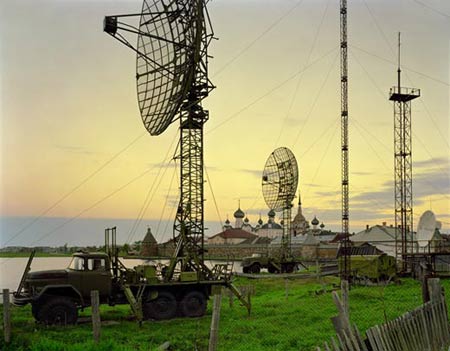
JC: Given what you said for you, as the photographer, a project like Russia must then be so much more than those photos, with all the stories and the memories behind the photos. I know that you also teach photography at Princeton and School of Visual Arts. To what extent do you share the non-technical aspects of your work? Or is this something that the students will eventually have to find for themselves, each in his or her own way?
AM: My friend Julius Shulman is very fond of saying that the camera is the least important aspect of taking pictures. With students I try to emphasize that photography is an extended process of decision-making and not about a singular “decisive moment”. (One revelation of the digital era is that this notion of “process” has been made quite explicit). So in my classes we talk about everything from very detailed technical issues, to questions of strategy for finding and approaching a subject, as well as personal and philosophical questions about the ideas that illuminate their images. I feel strongly that the collaborative aspect of picture making is ultimately what enriches and expands one’s ability to see and to know, and perhaps as their teacher, I’m one part of that collaboration. Often photography students start out thinking that they have to work alone, which may have something to do with cherished myths regarding the secretive or isolated artist. However, the best student work I come across is both inclusive in a personal sense and expansive with regards to culture and the world at large.
JC: Coming back to your own work, how do you deal with this? In Russia, how did you pick the sites that you wanted to take photos of? Russia is a huge country with a very complex - and, in the West, poorly understood - history. How did you decide what to include in your portrait of the country?
AM: One can’t help but be a tourist the first time you visit a foreign place. My method has always been to take repeated trips back to a location I’m interested in, and so each time I return I get a bit deeper and slowly peel back the layers. One helpful tool in this process is a notebook I keep of the pictures I’ve shot up to that point, which helps me determine what holes to fill when I return, and lets me keep in mind the overall scheme and arc of the project.
In the case of Russia, I was quite familiar with both its history and culture before I arrived the first time, but I hadn’t yet linked that knowledge to the more intimate understanding one gathers on the ground and in person. There is an amazing story of the poet Anna Akhmatova, standing in a line of women outside a prison during the Stalinist purges, all of them waiting in the remote hope of possibly seeing their jailed husbands. The women beside her knew she was a famous poet, and one whispered to her: “Remember this for us.” Perhaps more than any other country, Russia is a place where history weighs mightily, and every individual’s memory is laden, if not burdened, with the past. So I would say that despite what I knew of country’s history before I went, the most crucial and enlightening ideas were gathered from the stories people told me.
In thinking about the Russia book, I had two guiding principles. One was to avoid as much as possible any well-worn stereotypes. There are very few pictures of big housing blocks in my book (and none of Red Square) because these seemed like the most ready-made and clichéd images of life in the former Soviet Union. Instead I tried to work more around the edges of things, and in fact many of the places I photographed were actually located along the periphery of the country. I ended up shooting points east, west, north, and south but not so much in the middle of the country. Although this was somewhat an arbitrary choice, it worked out rather well, as one of Russia’s great historical problems has been a lack of clear boundaries with which to define itself.
The other idea was the use of contrasts, both within the subjects themselves and in the layout of the book. The type of subject I am most fond of shooting is that which presents a multilayered pattern of use and history. So, for example, I photographed a former synagogue that had been turned into a radio station, a monastery used as a gulag, a nobleman’s mansion transformed into a children’s theater, etc. For me these kinds of subjects present a cross section through time: they address Russia’s complex past, as well as the larger compacting and collapsing processes of contemporary history. In laying out the book I was able to address the same issues across the page spread. One of my favorite examples of this type of contrast in the book is an image of a worker sleeping in his dark and crowded shop surrounded by banners and girlie photos, juxtaposed against a picture of two scheming executives in their well-lit but empty “constructivist” office.
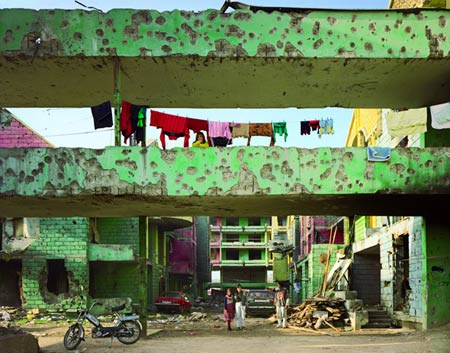
JC: That image of the monastery turned Gulag turned monastery struck me, because I had just read Anne Applebaum’s "Gulag: A History". Despite the fact that the book contained a fair amount of details, some of which I had even known beforehand (like the infamous visit by Maxim Gorky, who refused to see the place for what it was), seeing your photo sent a chill down my spine. It seems like photography has to power to show things in a different way, and especially contemporary fine-art photography appears to be getting increasingly involved in this process (as, for example, the images from New Orleans show). It seems the boundaries between pure photojournalism and fine-art photography are not that clear any longer, or maybe it is just that one takes photos with people and the other one without. But seriously, what do you think about this development?
AM: I think this debate about pictures with or without people is inconsequential as a matter of overall artistic value. However, and again referring to Julius Shulman, if you look at his best pictures, the people are as carefully orchestrated as the construction of the architectural space. His ‘characters’ locate the image in a particular point in time, and moreover, they enact a fantasy about American life, which is what I admire most about those images. Julius chose with care the models (or friends), clothes, props, etc. which most closely fit his vision of that space and accompanying lifestyle. Yet what he did best, and I have talked often with him about this, involved the “direction” of the people in his images, both their placement within the frame and their physical gestures. What makes his pictures extraordinary is the complex mixture of the real and the ideal, because in Shulman’s photographs his characters are both imitating life as well as offering up an idealized version of it.
For example, there’s a fantastic picture of a house shot from poolside in Palm Springs: a man in a bathing suit holds a towel wrapped around his neck with both hands while speaking to a woman who’s reclined in a chaise longue and shading the sunlight off her face with her raised hand (on the other side of the frame is the architect himself, Richard Neutra, seated and reading some papers). The couple’s relaxed pose balances out the aggressive industrial shapes of the house, and also embodies the idyll of postwar American life. Julius, even at 96 years of age today, is incredibly observant of the behavior of people, and he intuitively understood, much like a film director, how to get people into “character”, as well as how their poses would play out within the context of the larger “scene”. (Just by way of contrast, consider an artist like Saenredam, the 17th-century Dutch painter of church interiors and perhaps the first purely architectural artist. He created beautifully complex spaces out of Reformation interiors, but the little genre figures that provide a sense of scale and populate the lower parts of the panels were actually painted in by another artist.) As someone who loves and photographs architecture all the time, I truly admire Julius’ ability to place figures in his spaces: it’s extremely difficult to do well, perhaps more difficult than anything else, especially in large format, and Julius is absolutely a model to study for anyone interested in this problem.
As to your question about the blending of boundaries among the various modes of photography, I can only say this is a most welcome development. It reveals the continuing maturation of photography as a form of expression, and as a matter of practice, frees up the photographer from adhering to a set of fixed conventions. In fact, I think it is self-evident that the most interesting work of the moment is being done at the intersection of these formerly distinct styles, methods, schools, etc. (A rough analogy might be the phenomenon of ‘fake’ news programs, such as The Daily Show, which is far more content rich than the standard fare on broadcast news). We can disagree about the choice of subject or the meaning of the content, yet as a question of form, this process of shifting boundaries is not only inevitable, but also a very positive sign of photography’s continuing ability to create compelling images.
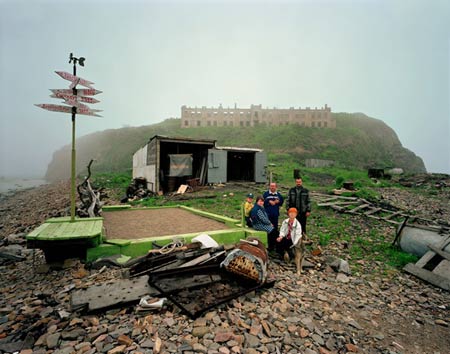
JC: I talked to Alec Soth about this already, and I’d like to ask you about it. There are many places or ideas, which have become photographic clichés. For a photographer it might be one of the biggest challenges to avoid simply falling for the cliché trap. Would you agree that this problem exists, and - if yes - how do you deal with it?
AM: I believe that the problem of the cliché image is endemic to the making of art. One has only to look at the plethora of stagnant history paintings so favored by the art academies of the 19th century to see that the problem of the “subject” is a profound one faced by artists of all periods.
Our particular moment in time has compounded this problem through the massive overproduction of images. I am not saying that there should be less art, as a general principle, but because of our ever-improved technology, we are able to produce images at an overwhelming pace, and not only that, we are also able to distribute them with extraordinary speed. So it’s no wonder that contemporary artists feel both overwhelmed and constrained given such a large-scale and efficient system of manufacture and distribution.
As an example of this, I recently brought to America my Russian assistant who had worked with me during my travels for the book. She shot for a month in America with me, and we traveled all over, from public swimming pools in East New York to ranches in the Sandhills of Nebraska. Whenever I asked her what she thought about these places, she said that nothing about them surprised her; she had already seen it all before in books, magazines, and movies. “You Americans have done a very good job of imaging yourselves” was her comment.
I agree that the United States may be one of the toughest places to shoot in terms of finding new subject matter. And it would seem to be one of the reasons why many photographic artists have turned away from an empirical approach in favor of a way of working that is more staged and suppositional.
However, as much as this dilemma does exist, I think there are two approaches that may help. The paradox is that one relies on technology, the other on history. Although some may feel that art and science share little in the way of sensibility, it’s evident that perception and technology are intimately connected through the history of art, whether it is the discovery of mathematical perspective, the developments of oil paint in tubes (hence plein-air painting), or large-scale digital photography. The question becomes, what can we do today that couldn’t be done twenty, ten, or even five years ago? What new ways do we have of seeing the world? I don’t believe this is an end in itself, but it certainly is one means for an artist to create a refreshed vision of things. I find the best solution is to embrace the entire spectrum of possibilities, from the most traditional methods to the latest and newest techniques, in order to have the widest palette available for my work.
The other approach involves a deepened understanding of history, both the history of image making and the overall flow and pattern of events that have created today’s world. It’s not simply a question of finding a new angle, but of seeing the world as it is evolving today. My sense is that our perception of the world, as influenced by the rapid evolution of information technology, directs us away from history and the past. It’s as though we view reality through a speeding car: the future, which is rushing toward us, appears immediate and vivid, while the past, which can only be viewed through the mirror, falls away into blurriness and quickly vanishes. I believe that if artists are engaged with the past, in whatever manner they choose, it can facilitate the ability to see a continuum between previous forms and the yet evolving contemporary ones. And if the dilemma of the cliché ultimately turns on the act of perception, then anything that helps the artist to see his/her subject in the state of “becoming” (and once formalized, permits the viewer to “re-perceive” this subject) is indeed a valuable tool.
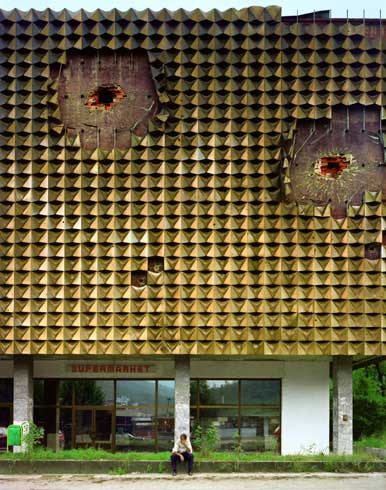
JC: The one thing that surprises me about this development, though, is the following. You would imagine that all these new “information technologies” would remove our ignorance of other places and even our own history, but I just don’t see that happening. I often think of photographic clichés as stereotypes that have become pictures. As a German, the things that I most commonly get to hear is that Germans make good beer and tools, have no sense of humor, and take boring photographs. And it is just so tempting to look for what you already know, and very hard to find something else. Coming back to your role as a teacher again, is this something that can be taught? Or does every photographer have to find it for him- or herself?
AM: Intellectual curiosity, in itself, just like an innate sense of proportion, can probably not be taught. One would hope, as a teacher, to develop in students an attitude toward learning, toward acquiring knowledge, and toward the sense of connectivity in everything they do. Emmet Gowin, a master teacher, calls this “the quality of attention”: it means developing an attitude in which everything you do, all the way from how you treat a piece of photographic paper, to how you behave with those you dislike, reflects at the deepest level the way you respect yourself. And I’ve always thought this was true, that the best teachers don’t insist on particular techniques and methods, but instead nurture an attitude and way of understanding oneself.
That said, I admit to be being a true believer in science and technology. I think the greatest miracle of the modern world is that we can open up our sleek laptops and through the ether itself, connect to the entirety of human knowledge, mistakes and all. On the flip side are the innumerable and everyday challenges of living in this complex, contradictory, and over stimulated system we’ve made for ourselves. Since unplugging is not really an option, except for the Luddites who can live in the forest and make tintypes, what we need at this point is a new model of reality. One branch of mathematics, which has metaphorical possibilities for what this new mental picture might look like, is something called Graph Theory. (This theory has made invaluable contributions to contemporary computer science and is popularized in such notions as six degrees of separation). It deals with a mesh of points in space containing multitudinous connections and how best to transfer information from one point to another in this system. It’s stable yet flexible, organized but not traditionally hierarchical, and reflects as accurately as any model I know the manner in which we both receive information and navigate through our contemporary surroundings.
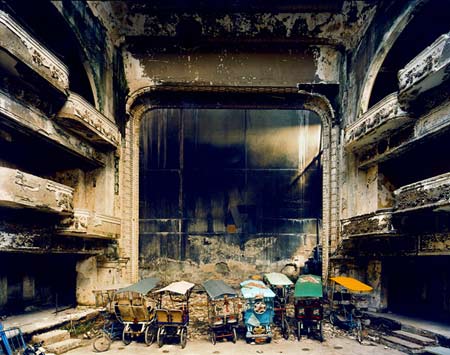
JC: I’ve recently heard quite a few complaints that contemporary photography has to too much an extent internalized what people believe to be the German school (which, in itself, I think, is largely a stereotype). It is said that there are too many photos with empty, drab scenes, portraits have become too detached, etc. Has contemporary photography become too “cold”?
AM: I think this is a most relevant question. Surely the success, especially in the marketplace, of the “Düsseldorf School” has encouraged photographers in the belief that objective photography is the best means to deal with our complex and contradictory world, and that more intuitive or lyrical approaches lead to a worldview that is out of sync or even nostalgic.
The great value of the German school is that its practitioners continue to look outward, to examine the world empirically, in opposition to the inward-turning, constructed set-ups that have dominated in recent American photography. That said, “objective photography”, as practiced by the Germans and influenced by a typological tradition which runs through Sander and the Bechers, is an intellectual distillation of reality through a precise definition of types and categories. I would say that this way of looking at the world is fundamentally Aristotelian, and it is highly effective when practiced with discipline, as the Germans have, and during periods lacking clarity and definition, which seems to be where we are now. (Perhaps it is not surprising that August Sander created his types during the disorder of the Weimar years). Even the most intuitive of the German photographers, Thomas Struth, creates thematic unity through this typological approach.
It is interesting to note that the set-up/tableaux approach, with its conceptual roots in performance art and appropriation, often employs romantic themes (lost love, the pangs of adolescence, virginal innocence, the isolated genius, etc). However, these themes are almost always held at arm’s length, and admixed with irony and/or an emotional remoteness. So in a sense, both schools end up feeling a bit cold, although approached from different points of view.
For myself, I am trying to synthesize many of these threads in contemporary photography to approach what might be called “conceptual realism.” As an American artist, some of this is rooted in 19th-century American painting and the empiricism of a thinker such as Thoreau, who saw the material world as the final expression of the spiritual, and not merely a stepping-stone to some higher level. As the poet William Carlos Williams once wrote, there are “No ideas but in things”. If you look at an early work by the painter George Caleb Bingham, such as “Fur Traders Descending the Missouri”(1845), you can see both the empirical and the visionary qualities harmonized together. So I believe that if contemporary photographers are to cast off the “coldness” of both conceptualism and the typological, they have to keep their eyes on the physical world about them, and at the same time see it as a manifestation of something much larger and mythological.
This conversation was commissioned by American Photo and can also be found here.
 By
By